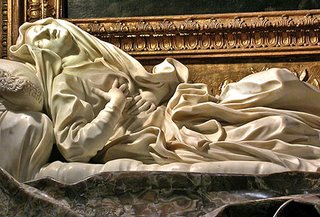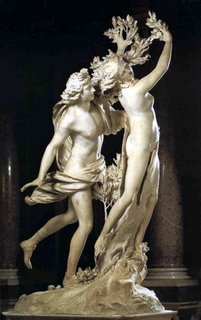
For a city as rich in renowned works of art as Rome, it’s not easy to single out one particular artist as one’s favorite. After more than two years here, I’ve been able to take in most of what the city has to offer. I can’t say that I’ve seen everything, since I’m still discovering new surprises on an almost weekly basis. But in terms of the best-known masterpieces, I’ve been fortunate to receive a liberal exposure to them all. I guess it’s one of the fringe benefits of taking out a hefty student loan and relocating across the Atlantic. Rome is a city bursting at the seams with unparalleled works of art. Paris, most likely, is Rome’s closest rival, but the Eternal City still stands heads and shoulders above the rest. Indeed, the Louvre owes much of its own repute to Rome, as a result of Napoleon’s relocation (some might call it stealing) of many of the city’s priceless works of art to Paris during his occupation of the city. But what museum in the world can compare to the experience of stepping into the Sistine Chapel, and elevating the eyes toward heaven? In terms of a single painting, there is probably nothing on the earth that can surpass Michelangelo’s sublime tour de force depiction of the history of mankind and salvation. As is the case when confronted with transcendent beauty, words fail to pay worthy homage to such a magnificent display of artistic splendor.
One of the experiences that I never tire of while in Rome is entering an inconspicuous church off the main drag, along a narrow cobblestone street, and stepping into what seems to me to be another world of indescribable beauty. Perhaps it is the Church of Saint Louis of France where, tucked into a side chapel, one will find a cluster of Caravaggio’s paintings. His stark realism and use of light and darkness always catch my eye. The simplicity of the subjects in his paintings is a striking feature, particular to him. There is no idealism to be found in the features of Christ or the Virgin Mary. They are normal human beings, just like us. This tendency of Caravaggio, to stress the unadorned humanity of his subject was, and still is, controversial. Should the Virgin Mary be depicted in art as a glorious queen or as a simple peasant girl? Does heaven meet earth in a Caravaggio, or does the viewer stay grounded? Opinions will vary.
Rome is the place to be for the aficionado of Baroque. I’ve narrowed down my own list of favorites in that genre, and Gian Lorenzo Bernini ranks at the top. He designed the vast, Saint Peter’s Square and the stunning baldacchino that rises above the high altar in the basilica. But it was his gift as a sculpture that makes him unique to me. Frozen in the middle of dramatic action, his subjects appear ready at any moment to burst free from their thin marble shells. The Galleria Borghese in the north of Rome hosts a generous supply of Bernini’s earlier works, many sculpted when he was only in his mid-twenties. One of Bernini’s best-known works is his Ecstasy of Saint Teresa, located in the Church of Santa Maria della Vittoria. Here, the artist captured the precise moment before the Saint’s heavenly visitor plunged his burning arrow, symbolizing God’s love, deep into her bosom. The expression on Teresa’s face, revealing a blend of pain and passion, coupled with the unearthly serenity of the angel, speaks volumes about the intensity of her mystical communion with God. That Bernini was able to carve out such a spiritually action-packed moment, from a cold block of marble no less, seems in itself a miraculous feat. Another powerful demonstration of Bernini’s skill can be seen at the Church of San Francesco di Grippa across the Tiber River in Trastevere. Here, Blessed Ludowica Albertone is depicted in the midst of one of her ecstasies. So impeccable was Bernini’s ability to capture the moment, and the movement involved in that moment, that there’s an undeniable fluid and airy quality to the light garments of his marble subjects.
Bernini never disappoints. Whether it is his athletic David, with lips pursed, torso twisted, on the verge of launching his deadly stone at Goliath, or Daphne caught in the very moment of being morphed into a tree to escape the clutches of the love-struck Apollo, or Saint Teresa’s mystical encounter with the Divine, Bernini’s genius was in his unrivaled ability to freeze dramatic action in his artwork, to stop time as it were.





Jim,
ReplyDeleteMy favorite sculptor/architect of the 17th century is Gian Lorenzo Bernini. Though his work can at times seem over blown and excessively dramatic, his sculptures certainly speak loud and clear. Bernini was able to combine sculpture and theatre to communicate the power and triumph of the divine to the illiterate and uneducated.
BMC
James,
ReplyDeleteI am happy to see that the blog is expanding to include interesting topics like art and your escapades (like your trip to Poland).
I am a fan of all the Berninis, and his virtuosity aside, I appreciate GLB's sense of humour. For instance the apocryphal story about the Fontana dei Quattro Fiumi's gods covering their eyes and holding their hands up in disgust before the neighboring facade of Borromini's Sant'Agnese in the Piazza Navona.
Or another of my favorite GLB surrounds his smiling elephant sculpture: To find out why it is smiling, the viewer must look at the elephant's rear. Its muscles are tense and its tail is off to the side. The animal's rear is pointed directly at the office of Father Domenico Paglia, a Dominican friar who was an antagonist of Bernini and his students, as a final salute and last word.
Imagine that poor friar having to walk past the elephant daily to and from work!
It's great that we agree on Bernini's genius. Some folks, quite often medieval romantics, are turned off by the power, drama and passion of Baroque art. I think it's very human, while at the same time, it offers the viewer a window into the divine. It is also very nice to see that we have a new guest on our little forum. At least we know that three people read this. We're making progress baby!
ReplyDeleteWere there any particular works of art that either of you savored while in Rome, besides Bernini that is? I'm always open to revisiting something with fresh insights.
-J.